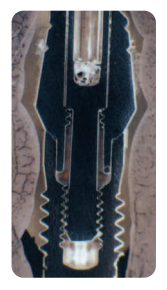I recently had the opportunity to choose which type of implants I want to place. As a general practitioner, cost is a large factor in choosing implants because of the need to keep overhead low due to low insurance reimbursements. While I am looking for lower cost implant options, quality for my patients is still very largely on my mind.
I recently saw this post from one of my former classmates, Alison Fishman DMD:

I discussed this case with my former classmate and she noted that it was a Taper Screw Vented Zimmer implant and that fractures like these have been found in her residency program on these types of implants as well as Biohorizon.
Since I have never had the experience of seeing this clinically and the fact that I learned implant surgery using Zimmer implants (which is by no means a “budget” implant system), I wanted to dive into this more. I read this 2011 Walter et al. article in the Journal of Oral Implantology entitled “Osseointegrated Implant Fracture: Causes and Treatment”. This article cited 3 reasons for implant fracture after osseointegration had occurred. (1) defects in the design of the material, (2) nonpassive fit of the prosthetic structure, and (3) biomechanical or physiologic overload. They found that defects in the design of the material were very unlikely reasons to cause these failures due to the lack of porosities or other defects in the titanium found on the failed cases. However, I think implant-abutment interface designs needs to be looked at closer when choosing what type of implant a practice is going to place. I honestly have not gotten to dive into this research further and I’m sure some does exist. Even despite not seeing research, hearing of these cases and looking at and reasoning through the Zimmer, Biohorizon and other internal hex implant-abutment interfaces, I am hesitant in placing these types of implants in my practice. If you look at the Biohorizon and Zimmer interfaces:


these photos show (perhaps the Biohorizon diagram shows it slightly better) that there is a very thin portion of the implant collar that forces are distributed to more so than other parts of the connection. These designs are in attempts to decrease the microgap between the implant and the abutment which has been found linked to peri-implantitis.
There is certainly an argument that if this type of connection were an issue the number of fractures would be more than Eckert’s findings of <5% implant fracture rate after 15 years. And this is certainly true, as Walter et al. discusses in the article prosthetic design and occlusal forces are the most likely causes for implant fracture. Thus these considerations extremely important on all implants, but is perhaps even more crucial for the internal hex connection implants. One prosthetic design considerations is reducing cantilevers present which can be done with proper implant placement and prosthetic planning. Another prosthetic design consideration is restricting the occlusal size of implant crown restorations, for example having a premolar sized prosthesis in the molar area. Occlusal forces considerations are to minimize the horizontal forces received by the implant and to reduce overloading the implant with straight vertical forces due to implant’s lack of a PDL. While these are always important concepts to know when doing implant dentistry, there are some factors that are out of doctors hands such as bruxim and parafunctional habits. While we can do our best to manage it with appliances, as Peter Dawson famously says “When teeth and muscle war, muscle always wins”.
Thus with all these considerations and my lack of confidence with the internal hex connection in bruxers, I have consider implants that have a morse-taper implant-abutment interface. Such is found with Straumann and NobleActive:


As you can see with these Figures these types of connections distribute more forces down more of the implant rather than just the collar, while still minimizing the microgap. Straumann and NobelActive are; however, some of the most costly implants on the market. Therefore, I’ve been attracted to the Blue Sky Bio|Max implants which use an interface that is similar to and compatible with NobelActive.

While these implants have only been on the market since 2012, a company like Blue Sky Bio has the advantage of using others’ successes and failures of implant design to create their own successful implants and provide them at a lower cost to providers.

Leave a Reply